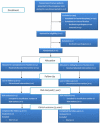Radiostereometric analysis of the initial stability of internally fixed femoral neck fractures under differential loading
- PMID: 30273993
- PMCID: PMC6587786
- DOI: 10.1002/jor.24150
Radiostereometric analysis of the initial stability of internally fixed femoral neck fractures under differential loading
Abstract
We examined the feasibility of radiostereometric analysis (RSA) in the assessment of the initial stability of internally fixed femoral neck fractures. The study included 16 patients (mean age 73 years). During surgery, multiple RSA-beads were inserted on both sides of the fracture. Radiographs for RSA were taken in the supine position within the first 3 days and 6, 12, 24, and 52 weeks after surgery. To detect any inducible motion at the fracture-site, radiographs for RSA were taken with the patient resting or applying a load through the fracture. Fracture loading was achieved by the patient pressing the ipsilateral foot as much as tolerated on a force plate while providing a counterforce through both hands. Micromotion exceeding the precision values of RSA (≥0.3 mm for the translation vector and/or ≥1.2 degrees for the rotation vector) was considered significant. Permanent three-dimensional fracture-site displacement was also recorded. Voluntary loading induced fracture-site micromotion, which exhibited a dichotomous distribution. In patients with uncomplicated fracture union, inducible micromotion was detectable only at baseline-if at all. Conversely, fractures that developed a nonunion were characterized by the continuation of inducible micromotion beyond baseline. Permanent fracture-site displacement was, on average, nearly an order of magnitude greater than the inducible micromotion. Fracture unions were characterized by the cessation of permanent fracture-site displacement by 12 weeks. Nonunions presented as outliers in permanent fracture-site displacement. Large-scale studies are warranted to evaluate whether the detection of inducible micromotion beyond baseline could serve as an indicator of insufficient fixation stability. © 2018 The Authors. Journal of Orthopaedic Research® Published by Wiley Periodicals, Inc. on behalf of the Orthopaedic Research Society.
Keywords: femoral neck fracture; fracture healing; internal fixation; radiostereometric analysis.
© 2018 The Authors. Journal of Orthopaedic Research® Published by Wiley Periodicals, Inc. on behalf of the Orthopaedic Research Society.
Figures






References
-
- Tidermark J, Zethraeus N, Svensson O, et al. 2002. Quality of life related to fracture displacement among elderly patients with femoral neck fractures treated with internal fixation. J Orthop Trauma 16:34–38. - PubMed
-
- Zlowodzki M, Brink O, Switzer J, et al. 2008. The effect of shortening and varus collapse of the femoral neck on function after fixation of intracapsular fracture of the hip: a multi‐centre cohort study. J Bone Joint Surg − Br 90‐B:1487–1494. - PubMed
-
- Zielinski SM, Bouwmans CA, Heetveld MJ, et al. 2014. The societal costs of femoral neck fracture patients treated with internal fixation. Osteoporos Int 25:875–885. - PubMed
-
- Ly TV, Swiontkowski MF. 2008. Treatment of femoral neck fractures in young adults. J Bone Joint Surg Am 90:2254–2266. - PubMed
-
- Bhandari M, Devereaux PJ, Swiontkowski MF, et al. 2003. Internal fixation compared with arthroplasty for displaced fractures of the femoral neck: a meta‐analysis. J Bone Joint Surg − Ser A 85:1673–1681. - PubMed
Publication types
MeSH terms
Grants and funding
LinkOut - more resources
Full Text Sources
Medical

